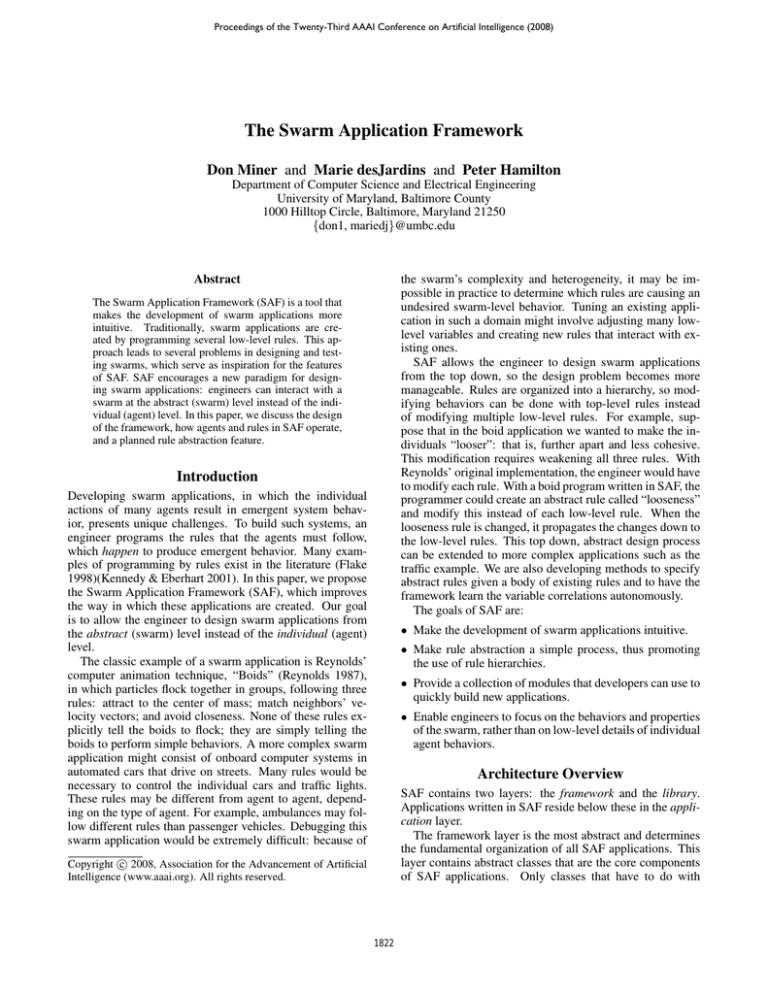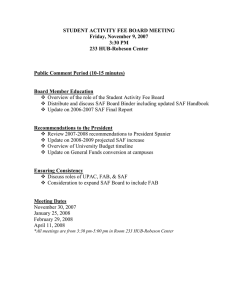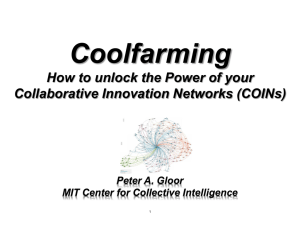
Proceedings of the Twenty-Third AAAI Conference on Artificial Intelligence (2008)
The Swarm Application Framework
Don Miner and Marie desJardins and Peter Hamilton
Department of Computer Science and Electrical Engineering
University of Maryland, Baltimore County
1000 Hilltop Circle, Baltimore, Maryland 21250
{don1, mariedj}@umbc.edu
Abstract
the swarm’s complexity and heterogeneity, it may be impossible in practice to determine which rules are causing an
undesired swarm-level behavior. Tuning an existing application in such a domain might involve adjusting many lowlevel variables and creating new rules that interact with existing ones.
SAF allows the engineer to design swarm applications
from the top down, so the design problem becomes more
manageable. Rules are organized into a hierarchy, so modifying behaviors can be done with top-level rules instead
of modifying multiple low-level rules. For example, suppose that in the boid application we wanted to make the individuals “looser”: that is, further apart and less cohesive.
This modification requires weakening all three rules. With
Reynolds’ original implementation, the engineer would have
to modify each rule. With a boid program written in SAF, the
programmer could create an abstract rule called “looseness”
and modify this instead of each low-level rule. When the
looseness rule is changed, it propagates the changes down to
the low-level rules. This top down, abstract design process
can be extended to more complex applications such as the
traffic example. We are also developing methods to specify
abstract rules given a body of existing rules and to have the
framework learn the variable correlations autonomously.
The goals of SAF are:
The Swarm Application Framework (SAF) is a tool that
makes the development of swarm applications more
intuitive. Traditionally, swarm applications are created by programming several low-level rules. This approach leads to several problems in designing and testing swarms, which serve as inspiration for the features
of SAF. SAF encourages a new paradigm for designing swarm applications: engineers can interact with a
swarm at the abstract (swarm) level instead of the individual (agent) level. In this paper, we discuss the design
of the framework, how agents and rules in SAF operate,
and a planned rule abstraction feature.
Introduction
Developing swarm applications, in which the individual
actions of many agents result in emergent system behavior, presents unique challenges. To build such systems, an
engineer programs the rules that the agents must follow,
which happen to produce emergent behavior. Many examples of programming by rules exist in the literature (Flake
1998)(Kennedy & Eberhart 2001). In this paper, we propose
the Swarm Application Framework (SAF), which improves
the way in which these applications are created. Our goal
is to allow the engineer to design swarm applications from
the abstract (swarm) level instead of the individual (agent)
level.
The classic example of a swarm application is Reynolds’
computer animation technique, “Boids” (Reynolds 1987),
in which particles flock together in groups, following three
rules: attract to the center of mass; match neighbors’ velocity vectors; and avoid closeness. None of these rules explicitly tell the boids to flock; they are simply telling the
boids to perform simple behaviors. A more complex swarm
application might consist of onboard computer systems in
automated cars that drive on streets. Many rules would be
necessary to control the individual cars and traffic lights.
These rules may be different from agent to agent, depending on the type of agent. For example, ambulances may follow different rules than passenger vehicles. Debugging this
swarm application would be extremely difficult: because of
• Make the development of swarm applications intuitive.
• Make rule abstraction a simple process, thus promoting
the use of rule hierarchies.
• Provide a collection of modules that developers can use to
quickly build new applications.
• Enable engineers to focus on the behaviors and properties
of the swarm, rather than on low-level details of individual
agent behaviors.
Architecture Overview
SAF contains two layers: the framework and the library.
Applications written in SAF reside below these in the application layer.
The framework layer is the most abstract and determines
the fundamental organization of all SAF applications. This
layer contains abstract classes that are the core components
of SAF applications. Only classes that have to do with
c 2008, Association for the Advancement of Artificial
Copyright Intelligence (www.aaai.org). All rights reserved.
1822
swarm behavior are included in this layer. The framework
layer contains top-level classes such as Rule, Agent, Environment, and Sensor, as well as more specific classes such
as Invoked Rule, Watch Rule, and Passive Agent.
The library layer contains an array of tools and other useful classes for swarm applications. The classes in this layer
are situational (yet domain-independent) and may not be
used in every application. Modules in this layer include
communications, basic rules, visualization packages, data
analysis tools, and basic environments. This layer will grow
as development of the framework continues and common
themes are identified.
The application layer is where swarm applications are developed. The engineer extends the classes provided by the
more abstract layers. Analytics, user interfaces, and other
supplementary components created by the developer reside
in this layer.
Figure 1: SAF Agents in the process of forming triangles
(Left) and agents that have formed a pentagon (Right).
is one of the major reasons why creating swarm applications with SAF is easier than creating them from scratch. In
many cases, abstracted rules can be defined explicitly by the
swarm application writer. We are currently exploring methods by which new abstracted rules can be learned, given a
set of existing rules. The properties to be exhibited by the
new abstract rule would be specified by the user; SAF would
then use simulation and generalization to modify and combine existing rules to achieve the new desired behavior.
Consider the example of agents forming a circle in a twodimensional environment, which can be accomplished with
three rules:
• Avoid closeness to other agents.
• Tend towards the center of mass.
• Move towards the average distance from the center of
mass. That is, calculate other agents’ distance from the
center of mass, average the values, and then tend towards
this average.
Each of these rules has a scalar factor that specifies its relative strength. Over time, an equilibrium is reached and the
agents form a stable circle. The radius and shape of this circle depends on the scalar factors in each of the three rules.
Now suppose that the programmer wishes to abstract these
rules into a single rule to “form a circle of radius r.” Our
research goal is to learn the relationship between the factors
in the three rules so that the abstracted rule “knows” what
to set the scalar factors to when a radius is specified. With
the learned abstract rule, the user can command the swarm to
form a circle of a specific radius instead of modifying the individual rules. Such learning can also be transferred to other
situations through generalization to swarms with a different
number of agents and different environmental constraints.
The abstraction based, top-down swarm design framework
provided by SAF, combined with the proposed learning extension, will provide a valuable and flexible tool for designing a variety of useful swarm applications.
SAF Agents and Rules
Agents in our framework are the deliverable end result of
an application written in SAF. Although applications are designed at the swarm level, the final compiled version is deployed into an agent program that is its own individual process. This separation ensures the flexibility of how these
agents can be deployed. Given the necessary communication abilities, these agents could be placed over an array of
desktop computers, a collection of individual robots, or hundreds of mobile wireless devices.
Each SAF agent is made up of two major components:
a body of rules and a data repository. The rules dictate
and control the behavior of the agent by performing all of
the sensing and acting. They are organized as a hierarchy,
where rules at the top are the most abstract. For example,
“form geometric shape” could be an abstract rule for a group
of agents that form shapes in a two-dimensional Euclidean
space. There are many underlying rules such as “form corner,” “avoid closeness,” and “become corner” that support
the abstract “form geometric shape” rule. The agent also
contains a data repository, which allows the rules to maintain the state of the agent, while the rules themselves can
remain stateless, simplifying their design.
Implementation Status
We have implemented a prototype of the framework and
are using it to develop simple swarm applications in a twodimensional Euclidean environment. These swarm applications use simple rule hierarchies to abstract low-level factors. In one application we have developed, agents form
geometric shapes by sensing their neighbors and changing
their own color, using no other means of communication between agents. Screenshots of this application in action can
be seen in Figure 1. More screenshots and videos are available on the SAF project website1 .
References
Flake, G. 1998. The Computational Beauty of Nature:
Computer Explorations of Fractals, Chaos, Complex Systems, and Adaptation. MIT Press.
Kennedy, J., and Eberhart, R. C. 2001. Swarm Intelligence.
Morgan Kaufmann.
Reynolds, C. W. 1987. Flocks, herds and schools: A distributed behavioral model. SIGGRAPH Comput. Graph.
21(4):25–34.
Learning Abstract Rules
Rules are the cornerstone of the SAF framework, driving
all agent behavior. Our rule abstraction mechanism in SAF
1
http:/maple.cs.umbc.edu/˜don/projects/SAF/
1823



